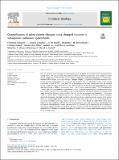Quantification of paleo-aquifer changes using clumped isotopes in subaqueous carbonate speleothems
Abstract
Here we track the water-table position and temperature of the Mount San Giovanni aquifer (Iglesiente-Sulcis mining district, SW Sardinia, Italy) during the past 600 ka by determining the ages (UTh dating) and stable isotope compositions (δ18O, δ13C and Δ47) of a variety of subaqueous carbonate speleothems (e.g. calcite spars, dogtooth calcite crystals and calcite coatings). Clumped isotopes (Δ47) provide quantitative estimates of carbonate formation temperatures (and thus water temperatures) that are independent of the oxygen isotope composition of water (δ18Ow). Then, the δ18Ow of the paleo-water has been reconstructed from the clumped isotope temperature (TΔ47) and the δ18O of the carbonate (δ18Oc). We find that high-temperature calcite spars formed already before 600 ka at temperatures above ~120 °C. Lower-temperature spars (~70 °C) precipitated at ~400 ka, and cold-water subaqueous speleothems (~10–20 °C) formed in perched ponds at different levels of the karst systems between 410 ka and 110 ka, while coeval precipitation of subaerial flowstones occurred in the upper levels of the shallower caves until 82 ka. We infer that the groundwater level dropped by ~120 m from ~400 to ~250 ka, with a relatively rapid rate of ~0.8 mm/y. Considering the tectonic stability of Sardinia during the Quaternary, this high rate derives from climate driven geomorphological processes at the surface rather than tectonic uplifting. The δ18O values of the paleo-aquifer water range from −6.0 ± 0.7‰ during MIS 5c, and similar to modern cave water values (−5.1‰), to −7.7± 0.4‰ during the colder MIS 8. These values indicate that the groundwater reflected the δ18O signal of meteoric water, with no significant contributions from metasomatism and metamorphic waters. The observed δ18Ow variability can be explained by glacial/interglacial paleoclimate changes affecting rainfall δ18O (and thus groundwater δ18O). We conclude that clumped isotope thermometry on subaqueous carbonate speleothems is a powerful tool for tracking paleo-aquifer temperatures and δ18Ow reconstructions.
Citation
Gázquez , F , Columbu , A , De Waele , J , Breitenbach , S F M , Huang , C R , Shen , C C , Lu , Y , Calaforra , J M , Mleneck-Vautravers , M J & Hodell , D A 2018 , ' Quantification of paleo-aquifer changes using clumped isotopes in subaqueous carbonate speleothems ' , Chemical Geology , vol. 493 , pp. 246-257 . https://doi.org/10.1016/j.chemgeo.2018.05.046
Publication
Chemical Geology
Status
Peer reviewed
ISSN
0009-2541Type
Journal article
Description
This study was supported by the NERC project, ID NE/M003752/1 to D.A.H. The sampling surveys were supported by the Water Resources and Environmental Geology Research Group (University of Almería). S.F.M.B., F.G. and D.A.H. acknowledge support from the European Union's Horizon 2020 Research and Innovation programme for project “QUEST” (Marie Sklodowska-Curie grant agreement No. 691037). Usingle bondTh dating was supported by grants from Taiwan ROC MOST (104-2119-M-002-003, 105-2119-M-002-001 to C.-C.S.) and the Research Center for Future Earth, National Taiwan University (107L901001 to C.-C.S.).Collections
Items in the St Andrews Research Repository are protected by copyright, with all rights reserved, unless otherwise indicated.

